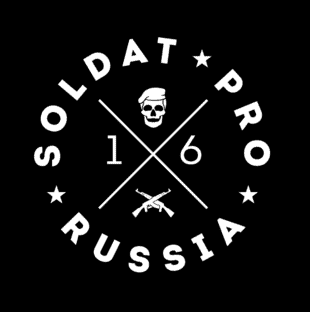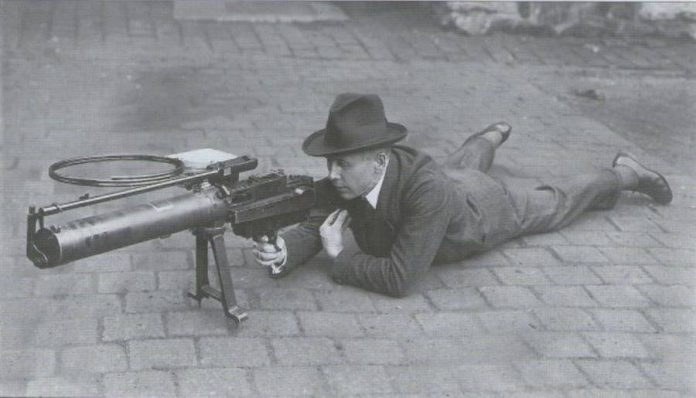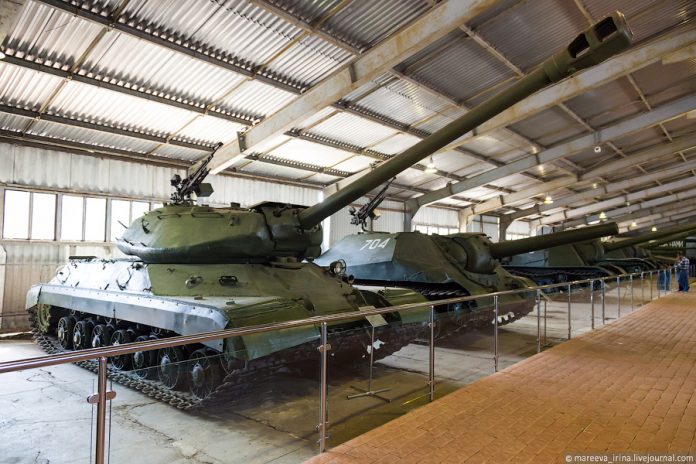
AT 1944 , work on the Soviet heavy tanks were going in two directions. The first was to develop a fundamentally new heavy tank, the designation object 701. The second direction was the deep modernization of the heavy tank IS-2. Later it was divided into major and minor upgrades — The latter led to the creation of the IS-2 with spryamlonnoy fore body component. Finally, spring 1944 year there was a third car, which was designated IS-6, was an initiative CB factory №100 and became, what is called, third wheel.
The new tank instead of upgrading old
In the early spring 1944 , it was reported the first results of the combat employment of heavy tank IS-85 (IS-1). It revealed, that the armor protection, as his arms, does not correspond to the realities of the battlefield. As for weapons in GBTU spacecraft known and so: since December 1943 , the release of heavy tanks began IS-122 (IS-2) with a more powerful 122 mm gun D-25T.
In the case of book news was extremely unpleasant. It turned, that the German 75-mm cannon KwK 42 L / 70 pierces the casing and forehead, and forehead Tower. For this reason, since the end of March, we started the project for the modernization of EC-2. Finally, they legalized the GKO №5583ss "On the manufacture of prototypes of a new heavy tank at the Kirov plant NKTP" from 8 April 1944 of the year.
In addition to designing and building prototype heavy tank facility 701, in the decision dealt with the upgraded IS-2. In the three-month period required to develop and manufacture an improved version of the tank. The main requirements were the strengthening of armor protection, as well as improving the reliability of the chassis and powertrain.
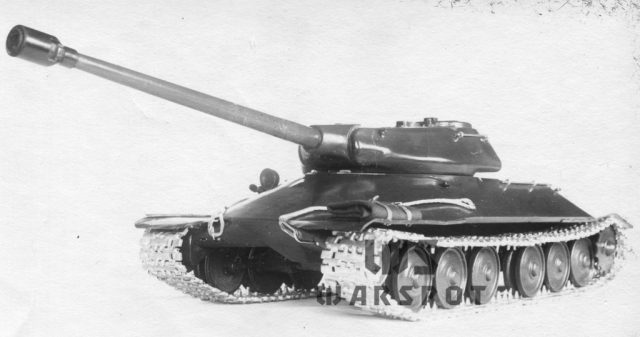 Modernization Project IS-2, developed by OKB plant №100 in April 1944 of the year. He formed the basis of the new tank project, which in April 1944 the year began to develop at the pilot plant
Modernization Project IS-2, developed by OKB plant №100 in April 1944 of the year. He formed the basis of the new tank project, which in April 1944 the year began to develop at the pilot plant
The main driving force in the development of a modernized the IS-2 was OKB pilot plant №100, directed by AS. Ermolaev. At the same time work began even earlier for modernization, as the first operating time appeared to decision GKO №5583ss. Furthermore, At first the plant №100 not quite work on the modernization of the conventional IS-2.
Project, developed under the leadership of NF. Şaşmurina, It was created by the tactical and technical requirements to heavy tank battle with weight 55-56 T - he was rather than upgrading the IS-2, a competitor more heavy and protection of facilities 701. By the way, These requirements imply a crew of 5 person - just so he was at the project of modernization of the IS-2 Shashmurina. Based on the operating time and the draft created over a known structure with field weight 46 t. In the previous design borrowed body with rational angles armor plates, chassis with supporting rollers of large diameter, tower with a notch tools through a hatch in the roof, and more.
By the end of April 1944 the DB plant №100 developed technical documentation for the project of modernization, It makes some wooden models, and ... that's all over. Despite the fact that in NKTP and GBTU spacecraft was correspondence according to the final shape of the IS-2 large modernization, Factory activity №100 on the subject has stopped. No, completely ignoring the work on the modernization was not, factory engaged in the manufacture of elements, which develops CSC-2 CHKZ. Nevertheless, own the modernization of IP-2 project at the plant №100 abandoned.
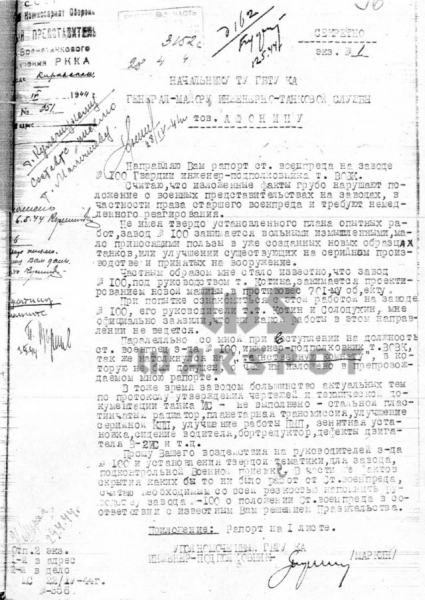 Action-production drama "Vovk military representatives and the Chamber of Secrets". She speaks eloquently about, that in the second half of April 1944 the DB plant №100 actively working on a new tank
Action-production drama "Vovk military representatives and the Chamber of Secrets". She speaks eloquently about, that in the second half of April 1944 the DB plant №100 actively working on a new tank
The first sign, that the EDO factory №100 has been far from a modernization of the IS-2, was the complaint of the new military representative at the plant engineer Guard Colonel A. Wolf. 18 April 1944 , he sent a letter to, in which he reported about the strange activity at the plant. At the factory, he found the room, at the entrance of which was put up security. New military representative was not allowed, citing the fact, that the inside can be accessed only with the personal approval of ZH.YA. litter. the question, what kind of room, Kotin said, that it is his personal work room.
In fact, in the "private room Kotin" worked NF. Şaşmurin, AS. Shneydman, G. A. Turchaninov and other designers. They had their own version: "This is a smoking room". scandal broke, on this occasion was a rough correspondence indicating the cause for ongoing projects and relationships with military acceptance to normal. Nevertheless, the activity of "outsiders" subjects not stopped. Chamber of Secrets was the place, where the work was carried out on the heavy tanks, which was to become a competitor to the Facility 701. Since such work on the part of NKTP could follow a serious problem, work took place in secrecy.
Clear and patronage to all this by Kotin: it is clearly not satisfied with the fact, that the pilot plant №100 from the center of the development of new models of armored vehicles turned into the structure, which should work in the wings. In its turn, ÇKZ, which was supposed to produce the development of plant №100, obzavolsya own KB, The object is engaged and 701. The relationship between the plant №100 and CHKZ particularly acute at the end of 1943 - early 1944 of the year. Against this background, the appearance of a competitor of the Object 701 looked quite expected.
Better IS-2, worse Object 701
Tank design, who was to become a direct competitor of the Object 701, entered the practical phase closer to May 1944 of the year. Despite the fact that the new project was directly related to the options for "big modernization" IS-2, Design Bureau of Plant No. 100 only partially used the developments on this topic. The thing is, that modernization itself was somewhat tied hands, as a number of IS-2 elements were to be used. Meanwhile, demands for a new heavy tank meant an increase in combat weight, armor protection, as well as strengthening weapons.
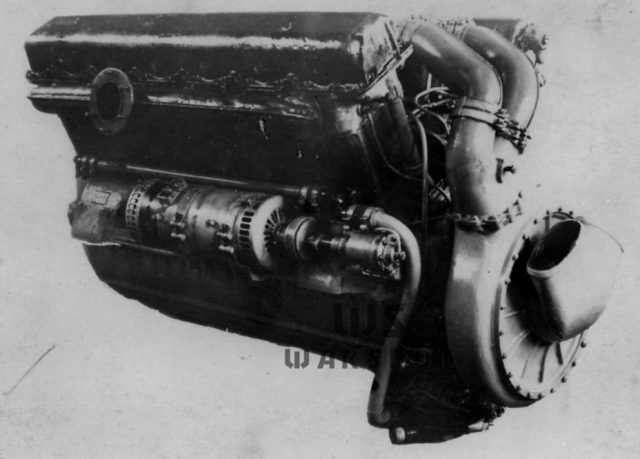 Engine V-12, which was eventually installed on the IS-6. In the embodiment for this tank, it was deformed to 700 HP.
Engine V-12, which was eventually installed on the IS-6. In the embodiment for this tank, it was deformed to 700 HP.
The increase in mass meant, that you need a more powerful engine. There were two candidates - B-11 or B-12, the latter was intended for a heavy tank 701. Due to the presence of an AM-38 air supercharger, the maximum power was estimated at 800 HP. In practice, such power could hold no more 10 minutes, therefore, later the maximum power was reduced to 750 HP. However, At first, Design Bureau No. 100 of the plant counted on a more modest V-11 engine with rated power 620 HP. (given the fact, that the combat mass was supposed to be at 50 t, that should have been enough).
A more interesting fact was that, that initially it was supposed to install an electromechanical transmission on the new tank. This type of transmission was worked out by a group of VAMM designers headed by N.I.. Gruzdev together with the plants Dynamo and No. 627 (by the way, famous science fiction writer A.P.. Kazantsev, held one of the leading posts at the plant number 627, had a direct relation to these works).
AT 1944 the year the protracted work led to the creation of an experimental tank ekv, built on the basis of KV-1s. The electromechanical transmission for the new tank of the development of the plant No. 100 was based precisely on the developments on the ECV. Later, as a fallback, implied the use of a mechanical transmission, while the combat weight was reduced to 48 t.
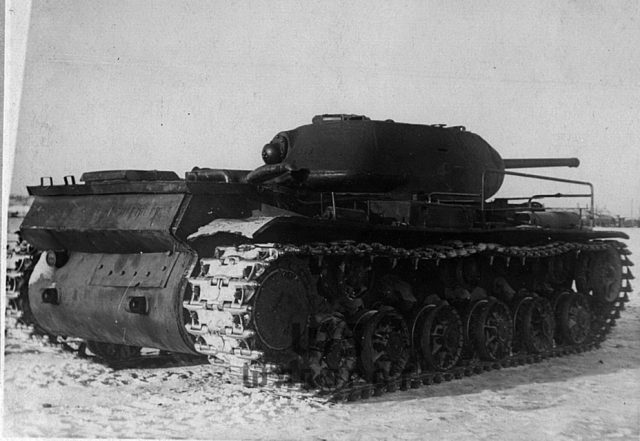 Experimental Tank EKV, which worked out the electromechanical transmission for heavy tanks
Experimental Tank EKV, which worked out the electromechanical transmission for heavy tanks
To ensure equal or close to the Object 701 of armor protection of design bureau of plant No. 100 closely cooperated with NII-48 located in Sverdlovsk. Institute Specialists, headed by A.S. Zavyalov, at that time had significant experience in developing new types of armor, and increase its durability. Most likely, cooperation with NII-48 was still during the design of new buildings and towers for the IS-2 major modernization. They concluded, what's the durability of armor plates, similar to Object 701, can be obtained due to more rational tilt angles.
A more powerful gun system was also provided.. Like the D-25T, she had a caliber 122 mm, but had to have an initial speed 850-900 m / s. true, at that time there were still no such guns.
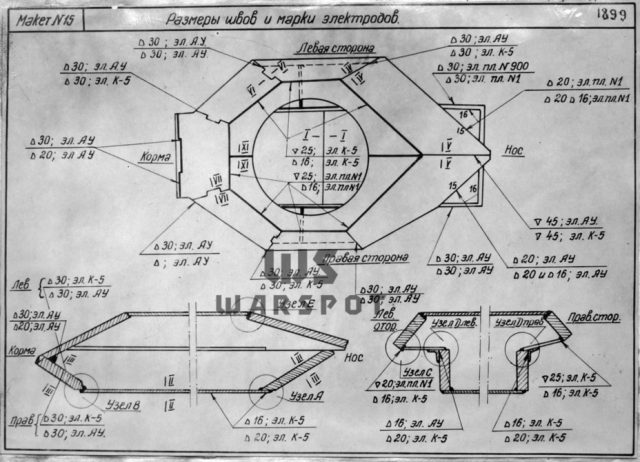 Layout diagram No. 15 with a thorn connection of armored plates. NII-48 considered this option a priority
Layout diagram No. 15 with a thorn connection of armored plates. NII-48 considered this option a priority
The senior engineer of the new tank was appointed G.N.. Moskvin, experienced in developing tanks and self-propelled guns. The already mentioned Schneidman was responsible for the installation of weapons. Ermolaev was responsible for the work as chief designer, and general management was provided by Kotin. In NKTP a draft of a new heavy tank was sent in early June 1944 of the year. Thanks to a rather high degree of study, Malyshev gave the green light to further work.
6 June 1944 years Malyshev signed an order for NKTP No. 379ss. In it, the tank received the designation IS-6. according to the order, UZTM connected to work on the experimental IS-6 tank, where the hulls and towers for this machine were made. TO 1 July was expected to produce working documentation on the hulls and turrets of the tank with a mechanical transmission, and to 15 number - drawings of the remaining units. UZTM handed over two sets of cases and a tower to 25 July, and the assembly of cars was completed 25 August.
TO 10 September expected completion of factory tests, to 20 a report was drawn up on them. Tank with electromechanical transmission expected later. Working documentation issued to 25 August, two sets of buildings and towers - to 10 October, the construction of two tank models was planned for 1 November, and the tests were carried out before 1 December.
In GBTU KA in their own way appreciated the IS-6. According to the commission, who considered the project, according to the main characteristics, this tank was not a step forward compared to the Object 701. On the other hand, it was significantly superior to the IS-2 - especially in armor protection. for example, armor protection of the hull due to rational tilt angles was superior to IS-2, but at the same time inferior to the Object 701. Approximately the same situation was with the armor protection of the tower - it was clearly superior to the IS-2, having maximum thickness 150 mm.
On the other hand, Object tower 701 was not only thicker (to 160 mm), but also had a smaller gun mask reservation, a, so, and less vulnerability. true, during the tests revealed, that the protrusion under the scope to the right of the mask is vulnerable, therefore, the final version of the tank had a wider gun mask reservation. The installation of weapons also caused a mixed reaction.
At that time, the 122 mm S-34 gun was considered the best option in the GBTU KA. On the IS-6, it was proposed to install a modernized version of the D-25 with an increased by 50 m / s initial velocity. The installation of this gun was criticized. It was also proposed to put a polik to improve the work of calculating the tower. The gun required a rammer and a barrel bore system. Not aroused much enthusiasm and the chassis with track rollers of large diameter.
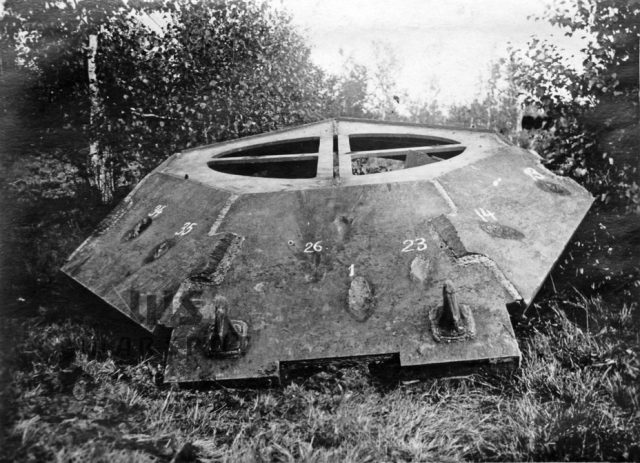 Layout number 15 during the test shelling
Layout number 15 during the test shelling
12 June a letter was sent to Malyshev from Marshal Fedorenko, in which he proposed to finalize the design of the IS-6 tank according to the tactical and technical requirements attached to the letter. Just to these tactical and technical requirements a lot of questions arose.. In GBTU KA, the ideal of a new generation heavy tank was a vehicle with a combat weight 50-55 t, the hull and turret of which would not make their way into the forehead with a 105 mm cannon with an initial projectile speed 1200 m / s. Such a gun was not in any German tank or self-propelled gun, but the GABTU decided to be proactive, and this is just the beginning.
105-mm gun with an initial speed 1000 m / s was not supposed to break through a new tank on board. Also, a 122-mm gun with an initial speed was installed in the tank 1000-1100 m / s and rate of fire 4-6 rounds per minute. The maximum speed of the machine was estimated at 40 kmh, and the average in 24 kmh. An engine with power was offered as a power plant. 1000 hp, who worked in conjunction with an electromechanical transmission.
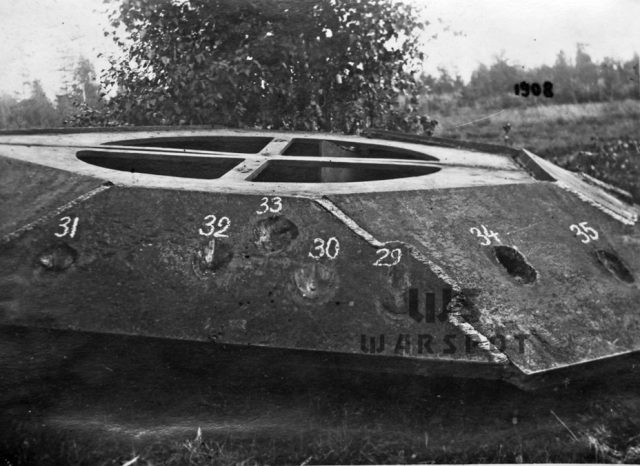 The results of getting on board the hull. Rational angles of inclination of the upper sheets of the side significantly increased the resistance of the armor
The results of getting on board the hull. Rational angles of inclination of the upper sheets of the side significantly increased the resistance of the armor
There were exactly two months left before the first battle with Pz.Kpfw.Tiger Ausf.B near Sandomierz, so against whom they were going to make such an armored monster, not quite clear. It was not clear and then, where to get such a gun and such a powerful engine. They did not understand this in NKTP. Similar requirements were repeatedly sent from GBTU KA, and there they believed, that the priority is electromechanical transmission. NKTP calculated the desires of the "tankers" for armor, giving an ambiguous result.
Assuming, what the military wanted, and from the tilt angles of the sheets of the hull and turret IS-6, it turned out, that the thickness of the forehead of the body grew to 130 mm, and the sides - to 170-207 mm. As a result, the combat weight of the tank would be 75-80 t. Also, NKTP noted with bewilderment, no so powerful gun, there isn’t such a powerful motor even in the project. They also accepted the idea of unitary loading with bewilderment - such a shot would have a mass 45 kg, not to mention the length is much more than a meter. The pick on this issue was not one month, in the end, the IS-6 still managed to defend in that form, how it was originally designed.
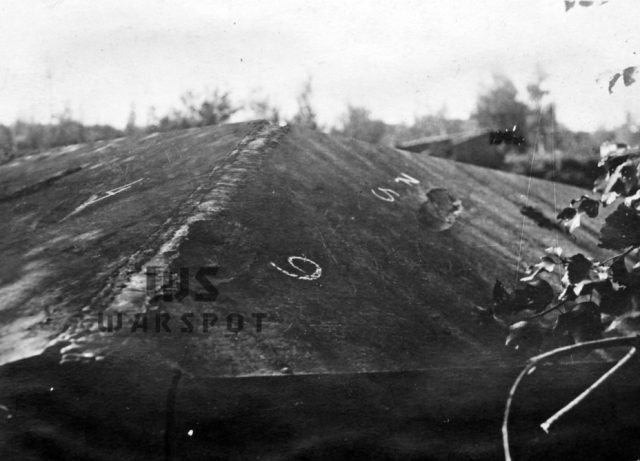 Hitting the weld area
Hitting the weld area
While NKTP and GBTU KA vigorously discussed the "tank of dreams", factory number 100, NII-48 and UZTM worked very fruitfully on the line of creating the optimal building for the IS-6. On the part of NII-48, this topic was supervised by Deputy Chief Engineer G.I.. The infidel. By early August 1944 years, special layout projects were prepared, which imitated the front and front side sheets of the tank hull. They were designated as “layout No. 15” and “layout No. 16”.
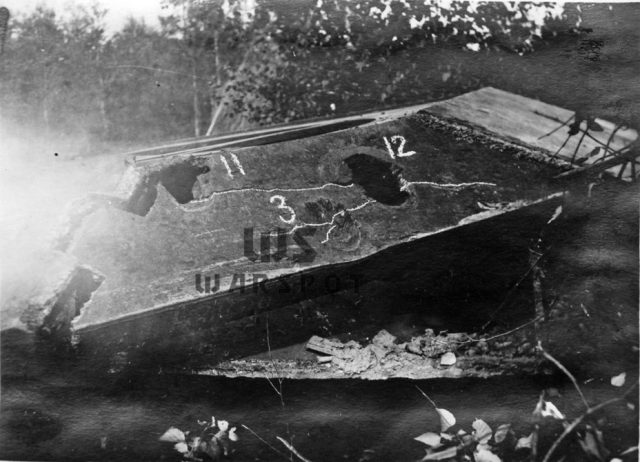 The body withstood the hit of a 105-mm anti-aircraft gun (hit number 3), but further hits of the 88-shells Pak guns 43 caused breaks and cracks
The body withstood the hit of a 105-mm anti-aircraft gun (hit number 3), but further hits of the 88-shells Pak guns 43 caused breaks and cracks
In terms of overall sheet configuration, both layouts were identical.. They repeated the design designed by Design Bureau of Plant No. 100, more precisely, its front. The difference was in the way the sheets were joined.. From the point of view of NII-48, the priority was layout No. 15, spike sheets. Layout No. 16 had sheets, quartered, with a “lock” at the junction of the upper and lower frontal sheets. From the point of view of the design bureau of plant No. 100, the variant with such a combination of sheets of the bow of the hull was more suitable.
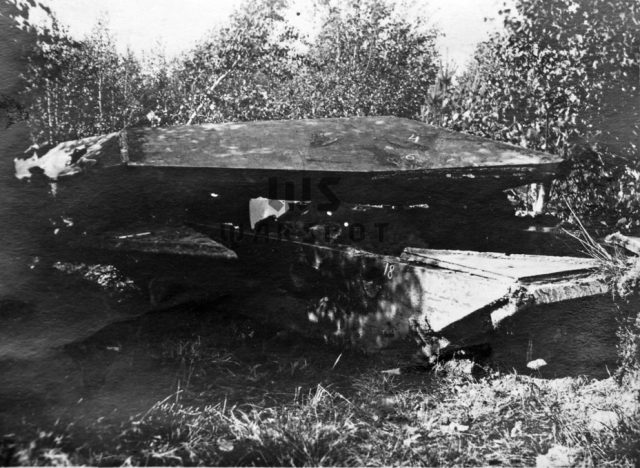 Destruction of welds was one of the key problems of the hulls of Soviet heavy tanks of the military period - this was especially true for UZTM products. Layout number 15 was no exception
Destruction of welds was one of the key problems of the hulls of Soviet heavy tanks of the military period - this was especially true for UZTM products. Layout number 15 was no exception
The timing, specified in the order of NKTP No. 379ss, failed to withstand. To a large extent, this turned out to be connected with the work on the hull. NII-48 sent a test program for shell models of shelling for approval 10 August 1944 of the year, by that time, UZTM had already two weeks to deliver hulls for a tank with a mechanical transmission, who received the designation Object 252. In practice, the shelling of the models took place only in early September 1944 of the year. The tests were carried out at the test site of the plant number 9.
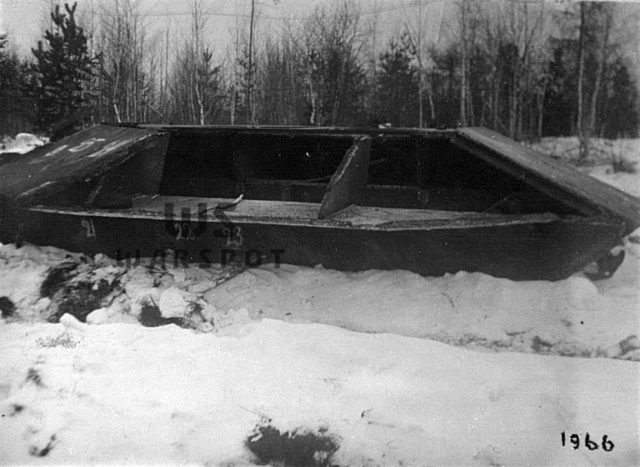 The result of shelling layout No. 17. The tests had to be stopped ahead of time due to the destruction of the welds
The result of shelling layout No. 17. The tests had to be stopped ahead of time due to the destruction of the welds
Test results were inconsistent. One side, the housing concept itself with large (65 degrees) angles of parts allowed to significantly improve their durability. If in the case of IS-2, having a straightened frontal part of the body of 90 mm sheets, the forehead was affected by the 88 mm Pak gun 43 at a distance of about 450 m and closer, then the forehead of the IS-6 was too tough for this gun. The same thing happened when shelling the forehead of the body with a German 105-mm anti-aircraft gun, as well as an 85 mm Soviet cannon with anti-caliber shells.
The same results were obtained when shelling the rear of the layouts.. The upper side sheets of the hull could only be penetrated by 88 mm Pak shells 43, and only from close range. Another question, that during shelling, the destruction of welds. Besides, the connection of the sides to the spike did not show significant advantages compared to the connection in the quarter.
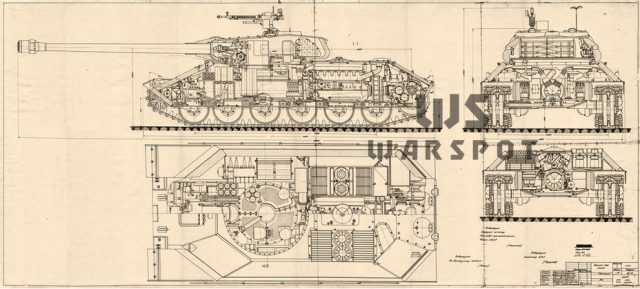 The final appearance of the Object 252 (IS-6), end of August 1944 of the year
The final appearance of the Object 252 (IS-6), end of August 1944 of the year
To check the results in December 1944 year was fired layout # 17, which was a variation on the theme of layout No. 15 in the bow and layout No. 16 in the stern. In this case, the layout was assembled from sheets, made of experimental armor IZ. As shown by tests of shelling, armor behaved worse, Cem th, what was used on previous layouts. As for the seams, then they collapsed much faster, and shelling tests ceased ahead of schedule.
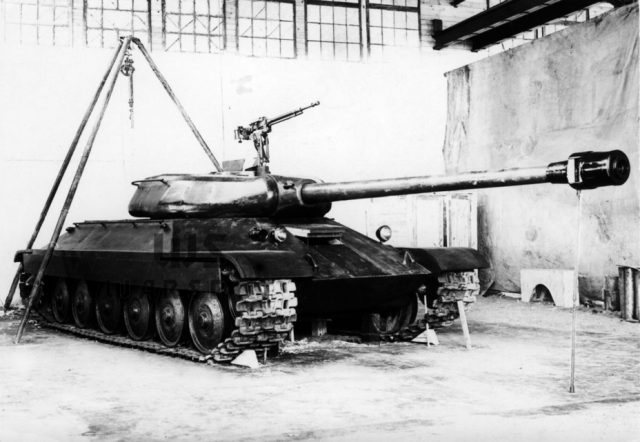 Full-size Object layout 252, autumn 1944 of the year
Full-size Object layout 252, autumn 1944 of the year
While the hull tests continued, at the factory number 100 was the design of the tank itself. Its appearance was formed by the end of August 1944 of the year. The appearance of the machine shows the impact of how the IS-2 major modernization, and Object 701. However, the car turned out to be a very original design, caught somewhere between IS-2 and the Object 701, as correctly noted in GBTU KA.
A somewhat strange solution was the insert in the upper frontal part of the hatch of the driver. His design was, of course, reinforced, but didn’t at all contribute to improving the durability of the most critical body part. The car turned out squat: the height of the viewing instruments of the tower was 2408 mm. for comparison, at the Object 701 this indicator amounted to 2480 mm, and in IS-2 - 2735 mm.
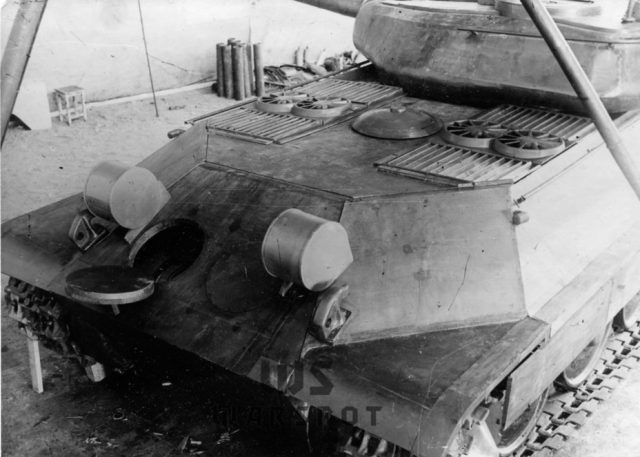 Close-up engine compartment
Close-up engine compartment
In the final configuration, the car received a V-12 engine, whose power was reduced to 700 HP. The general scheme of the mechanical transmission turned out to be similar to the IS-2. Similarly, he had an 8-speed gearbox with two-stage planetary gears in the tank. The cooling system was similar to the IS-2 in a major modernization program.. Unlike serial IS-2, radiators were located to the left and right of the engine (a similar diagram can be seen on the Object 701). Four fans were used to blow radiators, roof mounted.
by the way, at the factory, the resulting hull design in the area of the engine and transmission compartment was nicknamed the “casket” (for characteristic shape). As for the chassis, it, compared to the IS-2 large modernization, almost unchanged. It also used large-diameter track rollers in the same way., which allowed to abandon the support rollers.
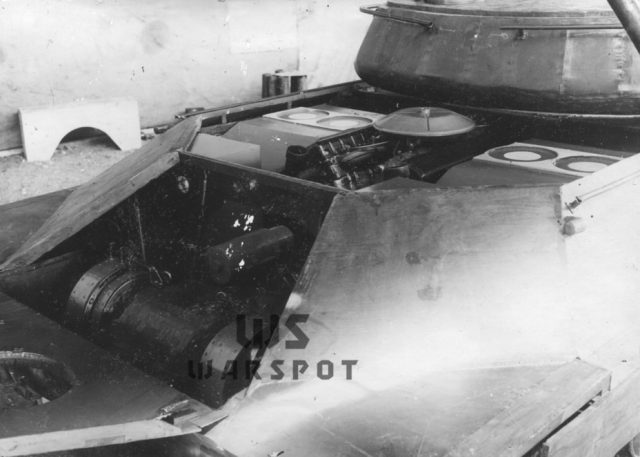 It is after the dismantling of plates. For its characteristic appearance, this design received the nickname "casket"
It is after the dismantling of plates. For its characteristic appearance, this design received the nickname "casket"
Similar to housing, when developing the tower, the experience of IS-2 was taken into account under a large modernization program, as well as Object 701. for example, from previous cars borrowed the low commander’s turret (more precisely, turrets, which were two), and also the notch of the gun through the upper hatch. At the same time, the design of the tower turned out to be quite original.
Besides, otherwise the issue of deploying ammunition was worked out. If the Object 701 shells were placed longitudinally in the feed niche, then at IS-6 they were placed as on IS-2, i.e. transversely. The total amount of ammunition amounted to 30 shots, which was tantamount to an Object 701 and a little more, than the IS-2. When developing the IS-6 combat compartment of the design bureau of plant No. 100, the comments of the GBTU KA were taken into account - in particular, a polyc appeared under the tower, which improved working conditions in the fighting compartment.
We should also talk about weapons. according to the draft, IS-6 was equipped with a 122-mm cannon with a coaxial machine gun (SG-43), another machine gun, DSK, used as anti-aircraft. Regarding the gun, there are a lot of interesting questions. As weapons, the 122-mm D-30 cannon is usually indicated - initially it was supposed to be a D-25T with an increased 50 m / s initial velocity. In fact, this tool was still the same, in terms of the initial velocity of the projectile, D-25T, but smaller and lighter. At the same time, there is not a shell rammer, she had no barrel bore system.
No different from the base and the muzzle brake. The thing is, that in parallel with plant No. 9, OKB-172 worked on the development of tools for the IS-6. This system bore the BL-13 index and was designed in collaboration with the Design Bureau of Plant No. 100. BL-13 practical work began in July 1944 of the year, not surprising, what exactly this weapon is in the project documentation and is visible on the IS-6 layout. At full barrel length 6002 mm gun had an initial velocity of the projectile 850 m / s, the issue of increasing the initial speed to 900 m / s.
For a number of elements, the BL-13 was unified with the D-25T. The same mechanized rammer was worked out for the gun., which is attributed to D-30. The same applies to the system purge the barrel with compressed air. According to calculations, maximum rate of fire reached 8 rounds per minute.
One of the stages of evolution
Despite the delay in the design and manufacture of the IS-6, factory number 100 back in August 1944 years began to put ideas into practice, sold in the tank. First of all, it concerned the chassis of the car.. Large diameter track rollers were manufactured in August (750 mm). When developing the rink, its maximum unification with the details of the rink and the suspension of the IC was paramount. As a result of parts with an index 252 the design was all 7 pcs.
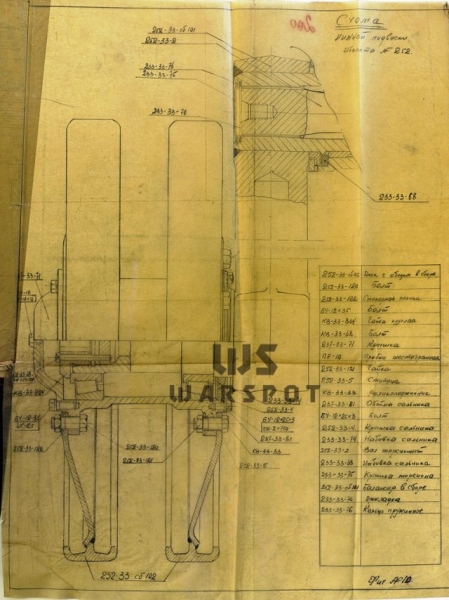 Track Roller, designed for IS-6
Track Roller, designed for IS-6
Since the prototype tank was not yet, manufactured track rollers put on the object 244. That was the name of the first prototype Object 237, redone for the installation of an 85-mm gun D-5T-85BM. The larger diameter of the track rollers led to, that sixth, the rear track roller remains old.
In this form, the tank for August-October 1944 overcame years 1875 km, of them 285 - along the cobblestone highway, 1571 - along the grader highway and lane, 19 - by continent. Of the total mileage 1589 km was covered in the standard configuration of the tank, and then Object 244 additionally loaded on 8 t, that is, to the actual combat mass of the Object 252. Instead 48 t really the car had a lot 51,5 t.
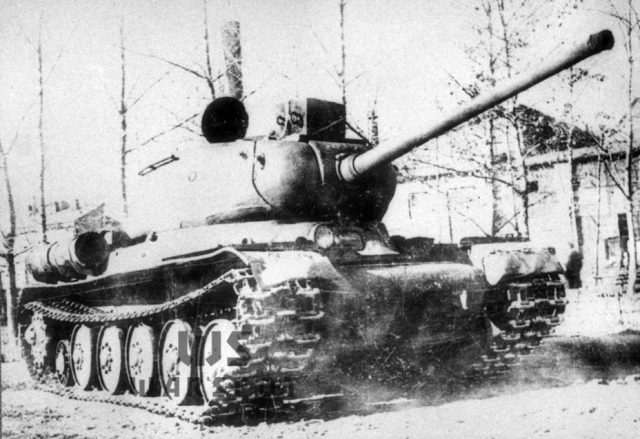 An object 244 with track rollers IS-6, loaded to combat weight 51,5 t
An object 244 with track rollers IS-6, loaded to combat weight 51,5 t
During the track roller test, they generally worked normally., but bolt loosening was noted. it, in its turn, led to the beginning of the formation of cracks on the disks of the rollers. As a result, at the 1425th kilometer run, one skating rink completely failed, and the second one at the 1480th kilometer run had a through crack length 350 mm. To prevent such defects, Plant No. 100 reinforced the design of the bolts.
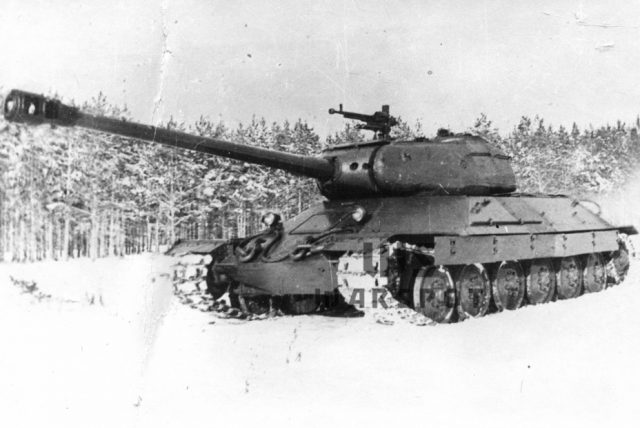 Prototype heavy tank IS-6 (An object 252) on tests, November December 1944 of the year
Prototype heavy tank IS-6 (An object 252) on tests, November December 1944 of the year
Assembly of the hull and turret first (and the only) Prototype Object 252 started at UZTM 20 September 1944 of the year. The hull was assembled from rolled medium-hard rolled armor, and the tower - from 70L high hardness armor. Welded sheet austenitic electrodes, other welding options showed poor results. In October, the building with the tower was sent to the factory number 100, where did the assembly of the car begin. At the same time, various elements of the machine were tested at Plant No. 100, including cooling system. Assembly partially completed by 8 November, on the same day sea trials began.
FROM 8 by 10 November the tank passed 319 km (100 - along the cobblestone highway and 219 - on a profiled highway), and the first 31 km he rode without a tower. The average speed on the cobblestone highway was 16 kmh, and on a profiled highway - 21 kmh. During the tests, problems arose with the VG-50 generator, the mounting bolts of the track roller discs were loosened. Another unpleasant call was, that revealed design flaws, connected to the body and tower of the machine. The hatches of the tower turned out to be small, when the driver’s hatch was open, poor visibility was observed. Besides, driver-driver rested his head on the upper frontal sheet of the body.
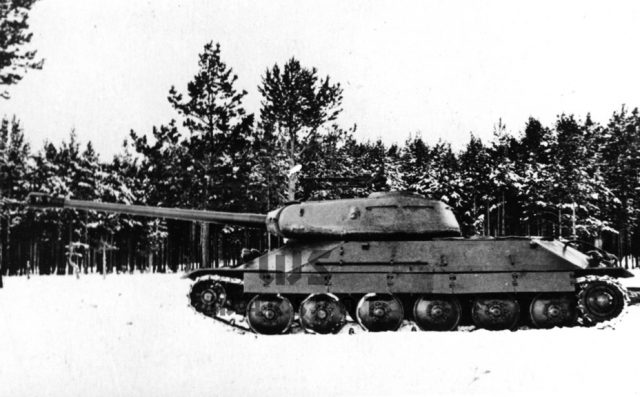 Tests showed low machine reliability - especially for track rollers
Tests showed low machine reliability - especially for track rollers
TO 8 December 1944 years IS-6 overcame 825 km, of them 315 - along the cobblestone highway, 420 - on grader highway, 90 - by continent. Maximum average speed, test results, was 22-24 kmh. true, at high speeds a strong (90-105 degrees) gearbox heating. Considering that, that the thing happened in November-December, can imagine the situation in the summer. When squeezing the main clutch, effort was required 60-65 kg, however, it was noted, that the car turns easily. However, gearbox heating was a small problem compared to the situation around the track rollers.
for 825 km of path failed 14 Track roller, the average durability of the rink did not exceed 200-300 km. In this regard, the design bureau of plant No. 100 has developed a reinforced roller, however, and he, as it appears, did not become the final solution to the problem. Another serious problem was the operation of the VG-50 generator. There were complaints about the K-73 DC generator. Fuel Tanks (480 l) only enough for 100-120 kilometers.
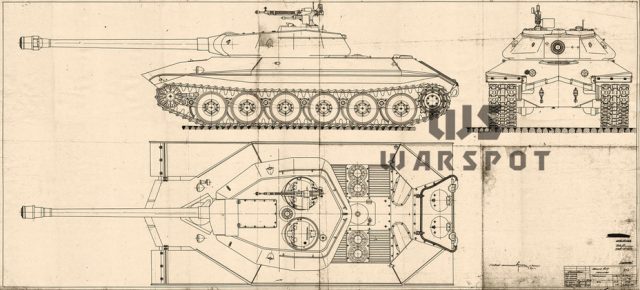 Project Design 252 with a modernized nose, end of November 1944 of the year
Project Design 252 with a modernized nose, end of November 1944 of the year
In the second half of November 1944 years design bureau of plant No. 100 developed a modernized version of the facility 252. It implemented a new bow, developed by V.I. Tarotko. For the characteristic shape, she received the nickname "pike nose". This allowed not only to increase the resistance of armor plates, but also transfer the driver's hatch to the roof of the control compartment. A similar design was received and the upgrade option IS-2, received the designation IS-2U.
As for the IS-6, then he was sent to Moscow at the direction of Kotin. The outline designs of the IS-2U and the upgraded IS-6 went there, however, it couldn’t help IS-6. December 1944 years at the NIBT Test Site passed the tests of the heavy tank "Kirovets-1", aka IS-3, aka Object 703. This tank was not so revolutionary, like IS-6, but was much more reliable (this is especially true for the chassis). Besides, the tank has significantly increased armor protection. After weighing all the pros and cons, in GBTU KA and NKTP decided to further develop Kirovets-1, passing SKB-2 ChKZ operating time on IS-2U and IS-6. In fact, this meant the death of the IS-6.
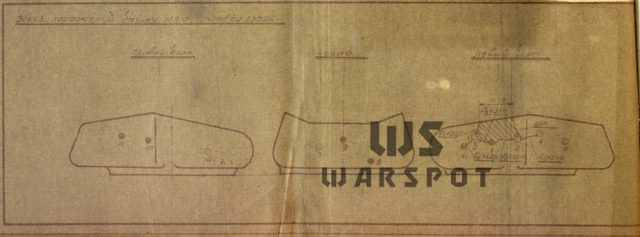 The result of shelling the tower IS-6, made of steel 70L
The result of shelling the tower IS-6, made of steel 70L
Another blow to the IS-6 program was the results of shelling towers, made by UZTM from steel 70L and 72L. fire, held in early January 1945 of the year, showed, that the side of the tower number 5A of steel 70L thick 150 mm penetrates 88 mm Pak gun 43. Of 12 hits from different angles of penetration were achieved in 7 cases. The situation with tower No. 5 turned out to be even worse, made of 72L steel - after five hits, the tower split in two. This meant, that the tower does not have sufficient protection from the gun, which she had to withstand. Worse, the IS-6 turret was given by the design bureau of plant No. 183 as a model when designing the turret of the experimental T-54 medium. As a result, later they decided to redo it according to the type of IS-3, without even shelling.
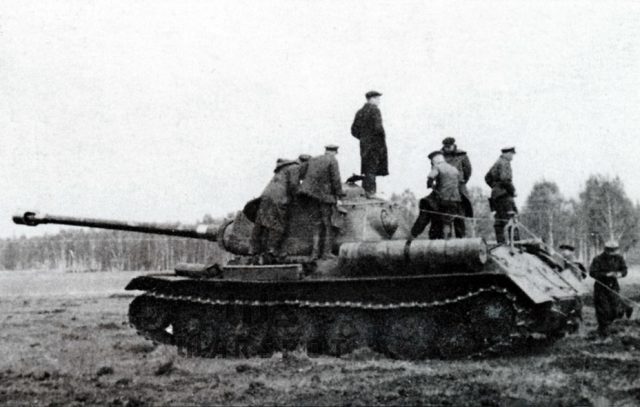 Testing of new rollers for IP-6 and 122 mm cannon BL-13 Object 244, 1945 year
Testing of new rollers for IP-6 and 122 mm cannon BL-13 Object 244, 1945 year
So sad results are not meant, that of EC-6 completely stopped. The tank is tested various mechanisms. for example, winter and spring 1945 year it worked out hydro-servo planetary rotation mechanism. Continued work on the upgraded track rollers - they have increased in diameter to 800 mm, and now design more like a support roller IS-2. The first samples of rollers placed on the object 244 December 1944 of the year, he went to them 305 km, yet 393 km was overcome in January 1945 of the year.
Finally, will not go away 122-mm gun BL-13 - for her work continued, at 1945 , the gun came to the test. true, We experienced these items at the Facility 244 and IS-2, and on-MI-6 were more like the prelude to a new tank. 19 February 1945 Vovk year again complained about the "secret rooms", that appeared in the factory №100. With the approval of Kotin EDO №100 secretly plant start developing tank, who later received the designation object 257. He was also the first tank, received the designation IS-7.
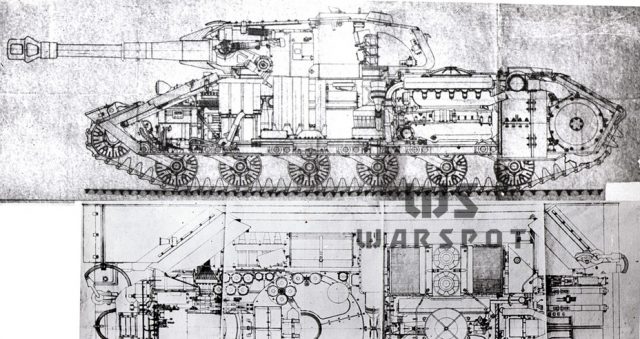 Longitudinal and cross-section of the Object 253. Interesting, that 122 mm is shown in longitudinal sectional gun D-30, And with a muzzle brake "for the type of Ferdinand"
Longitudinal and cross-section of the Object 253. Interesting, that 122 mm is shown in longitudinal sectional gun D-30, And with a muzzle brake "for the type of Ferdinand"
Against the background of the problems, identified when creating objects 252, somehow lost machine, which was to get an electromechanical transmission. She received the factory designation object 253, He was the lead engineer of the machine MI. Kreslavskij. Developments on the project theme 253 It began in October 1944 of the year, thus immediately sounded the alarm bell. When tested generators G-73 their drive is heated to a temperature 119 degrees. However, due to identify the problem with the Object 252 electromechanical works on his brother dragged.
Information about the test of the tank in October-November 1944 year is not true - in this period, the plant №100 not speak about it any words. Furthermore, any objects 253 №100 in the reports of the plant is not in January, or February 1945 of the year.
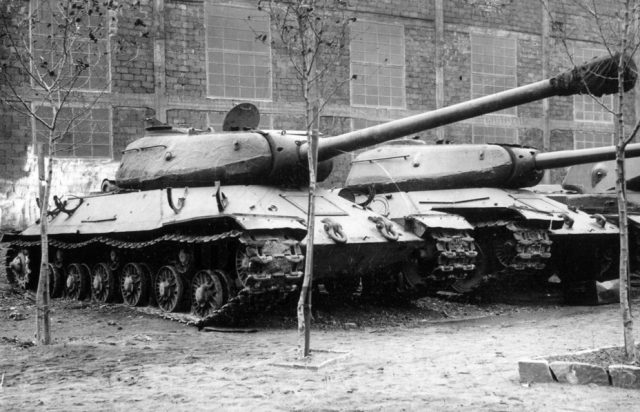 An object 253 after the end of the test. Behind him is visible object 252
An object 253 after the end of the test. Behind him is visible object 252
initially, object 253 should differ from the Facility 252 Only electromechanical transmission. It was developed in conjunction with the plant "Dinamo", to gain more experience in the development of ECI. for example, DC-motors 302A and 302B DK-steel development engine family DC-301, which were used in the ECI. The general scheme of electromechanical transmission also had a lot to do with the ECV.
The main advantage of electromechanical transmission was easy to operate - the truth, for it had to pay a significantly higher weight machines. Battle an array of objects 253 was 54 t. Given the problems, which arose from the road wheels Facility 252, factory №100 not take the risk and put on the IS-6 road wheels of the IS-2.
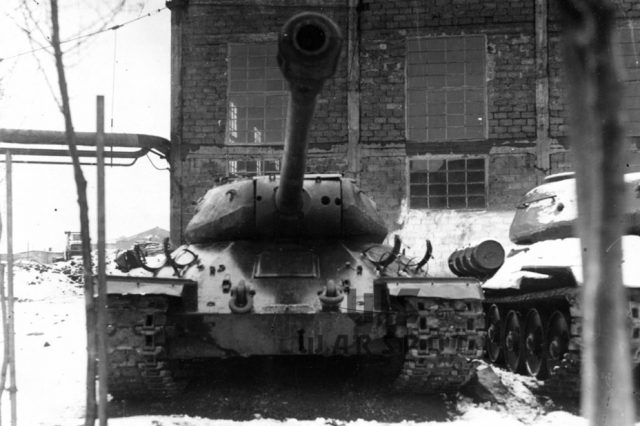 Outwardly the car with electromechanical transmission had a number of differences
Outwardly the car with electromechanical transmission had a number of differences
The history of the construction and the test object 252 shrouded in darkness. This machine had to be completed in the first quarter 1945 of the year, but in correspondence more precise information on this matter is not. The reason for this was extremely bad test results, which are known only by the memoirs of designers, create a tank. As he wrote Kreslavskij, after 10 km after the start of run of the car lost control due to a fire in the transmission compartment. In this test subjects 253 stopped - at least, It is the most common version of events.
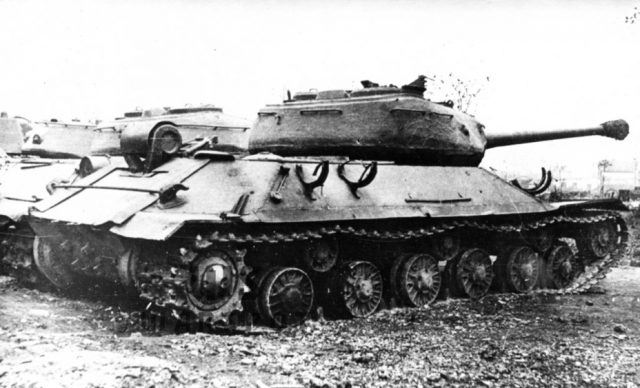 During the recovery tank 1946 It was little changed top aft hull plate
During the recovery tank 1946 It was little changed top aft hull plate
In reality, the story of the object 253 He had continued. The reason for this was the further work on heavy tank IS-7. This tank was worked with several embodiments of the transmission, including electromechanical. To break this scheme required test laboratory, therefore 1946 year of the tank-loser again remembered.
According to the plans of work of the Ministry of Transport Engineering at 1946 year, to test and fine-tuning of the tank allocated 1,5 million rubles. Contractor acted plant №100 branch in Leningrad - the way, We went to the same elements of the electro-mechanical transmission with the German super-heavy tank Pz.Kpw.Maus. restore object 253 We finished in January 1947 of the year, after which the car has passed 34 km. Further tests showed some problems - in particular,, divestment of the tank in the direction of. Tank testing ended in June 1947 of the year, By this time he overcame 1025 km. As a matter of fact, the known photographs of the machines are made after the passage of test data.
Both tanks (objects 252 and 253) later put into scrap metal. For Soviet tank they have become something of intermediate samples, and have fallen victim to structural deficiencies. In addition, the IS-6 from the beginning was not considered spacecraft GBTU a machine for the mass production. "Intermediate" car characteristics, placing it between IP-2 and Object 701, It did not contribute to the manifestation of the great interest on the part of the military to mass production. The appearance of the end 1944 year "Kirov workers-1" has deprived EC-6 of any chance of serial production.
sources:
— CAMO RF
— RGAE
— Archive Igor Zheltov
— Archive Sergey Netrebenko
— Archive Cyril Koksharova
/Yuri Pasholok, warspot.ru/







